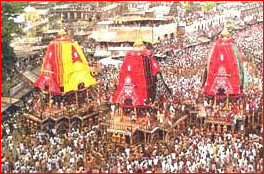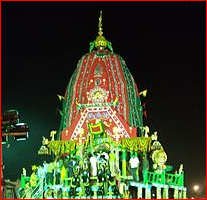Puri Jagannath Ratha Yatra Chariots
The three chariots (Raths) used for the annual PuriJagannath Ratha Yatra are newly constructed each year. A particular family of
carpenters owns the hereditary right to construct the chariots. The
construction of the chariots begins on the Akashya Tritiya day, which is around
three months before the actual Ratha Yatra day. Each chariot used in the Rath
Yatra has specific size and dimensions. The chariots are a classic example on
indigenous engineering marvel.
Sal wood is used for the construction of the chariots. The
wood is brought from the forests of Daspalla and Ranapur. Around 2,188 pieces
of wood are needed for the construction of the chariots and these are chiseled
out by around 125 carpenters. They work for 58 days at the Mahakhala – the
front portion of the Palace located near the Jagannath Temple.
Iron nails, brackets, clamps and other miscellaneous items
needed for the chariots are prepared by the native blacksmiths. The structure
above the wheels contains eighteen pillars and roofs at various stages. Each
chariot contains nine subsidiary deities, two doorkeepers, and one charioteer
all of which are made of wood. Apart from this each chariot has a crest banner.
Around 1090 meters of new cloth is used to cover each
chariot. Each chariot is fastened with four long ropes manufactured from
coconut fibers. The ropes are provided by Kerala Coir Corporation.
CHARIOT OF LORD JAGANNATH
 The Chariot of Lord Jagannath is known as Nandighosha. It is
also known as Garudadhwaja and Kapidhwaja.
The Chariot of Lord Jagannath is known as Nandighosha. It is
also known as Garudadhwaja and Kapidhwaja.
Height: 13’.5m
Number of wheels: 16 (seven feet diameter)
Length and breadth: 34’6” x 34’.6”
Wrappings: Red, Yellow color cloths
Total Number of wooden pieces used: 832
The Rath (chariot) of Lord Jagannath is guarded by Garuda –
the mythical bird and vehicle of Lord Vishu. The charioteer is called Dahuka
and the flag is named ‘Trailokyamohini.’ The wooden horses driving the chariot
are named as Shankha, Balahaka, Suweta, Haridashwa. The rope used to pull is
called Sankhachuda. There are nine presiding deities in the chariot – Varaha,
Gobardhan, Gopi Krishna, Narasimha, Rama, Narayan, Trivikrama, Hanuman and
Rudra.
The Chariot of Balabhadra is known as Taladhwaja.
Height: 13’.2m
Number of wheels: 14 (seven feet diameter)
Length and breadth: 33’ x 33’
Wrappings: Red, bluish green color cloths
Total Number of wooden pieces used: 763
The chariot of Balabhadra is guarded by Vasudev. The
charioteer is Matali and the flag is named ‘Unnani.’ The horses are called
Tribra, Ghora, Dirghasharma and Swornanava. The rope used is named basuki.
Ganesha, Kartikeya, Sarvamangala, Pralambari, Hatayudha, Mrutyunjaya,
Natamvara, Mukteswar, and Shesha deva are the nine presiding deities.
CHARIOT OF SUBHADRA
Height: 12’.9m
Number of wheels: 12 (seven feet diameter)
Length and breadth: 31’.6’’ x 31’.6’’
Wrappings: Red, black color cloths
Total Number of wooden pieces used: 593
The chariot of Subhadra is guarded by Jayadurga. The
charioteer is called Arjuna and the flag is Nadambika. The horses are Rochika,
Mochika, Jita and Aparajita. The rope is called Swarnachuda. The nine
subsidiary deities in the chariot are all female deities – Chandi, Chamunda,
Ugratara, Vanadurga, Shulidurga, Varahi, Shyamakali, Mangala and Vimala.
Related Articles :)







